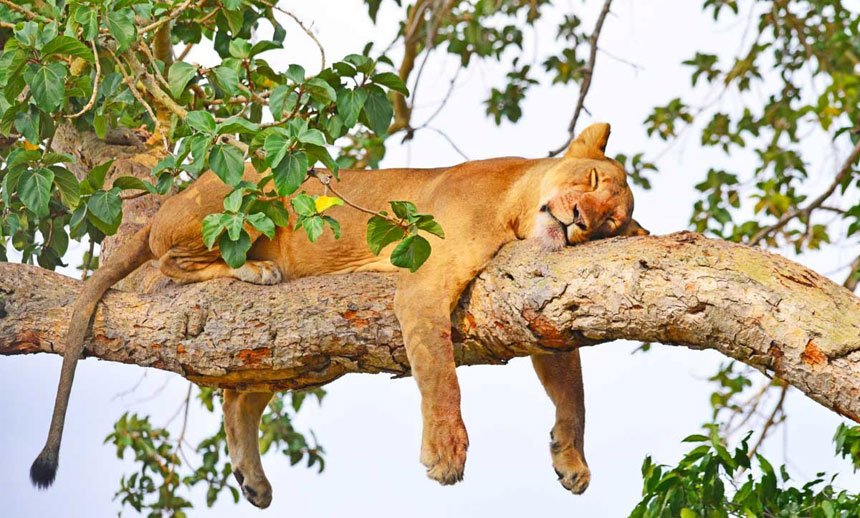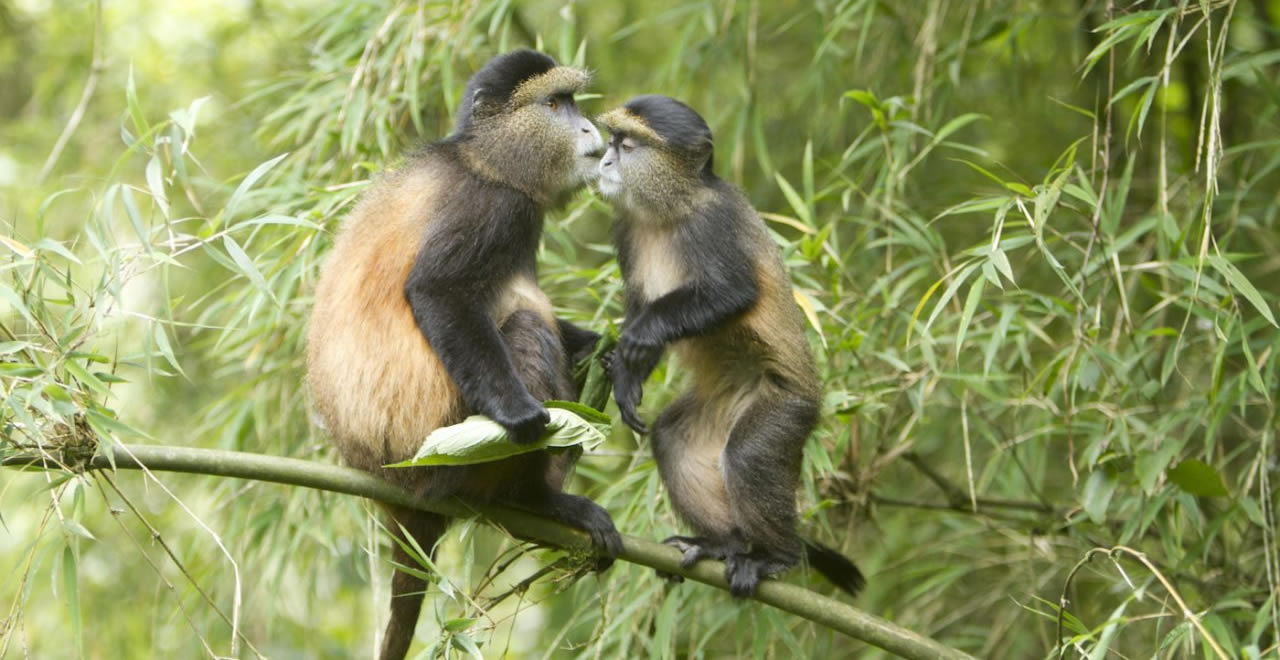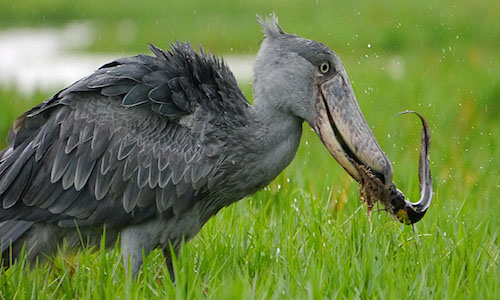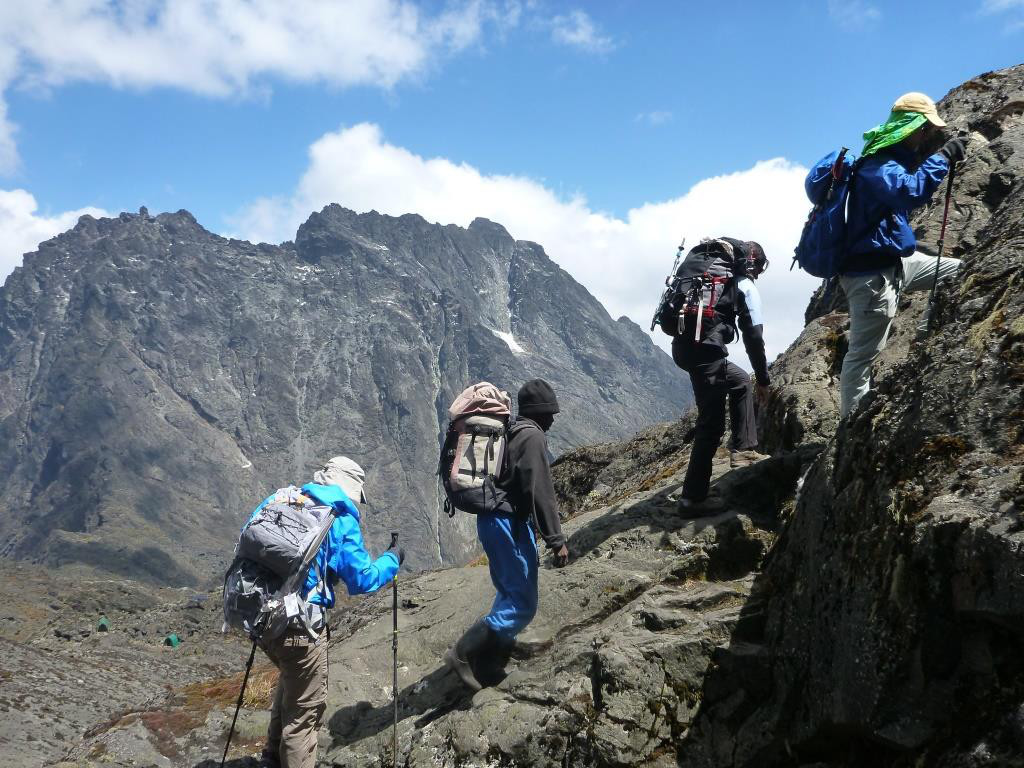Volcanoes national park was the first protected area in Rwanda, established in 1925, it covers 160 sq.km in Northern Province. It lies in the Virunga Massif, a chain of 8 volcanic mountains along the borders of Uganda, Rwanda and DR Congo, of which the park contains 3 dormant volcanoes including Karisimbi, Bisoke and Sabinyo The tallest volcano in Rwanda is Mount Karisimbi 4,507m (14,787 feet), which is relatively younger along with Mount Bisoke 3,711m (12,175 feet), which has a crater filled lake on the summit. Mount Sabinyo, which straddles the borders of both countries, is the oldest volcano having been formed during the early part of the Pleistocene Epoch about 2,600,000 years ago. Due to its early formation, its summit has a jagged peak that resembles an old man’s teeth. The park enjoys a cool tropical climate year-round with day temperatures ranging between 18 to 23 degrees Celsius. Due to higher elevations, nights can be cold with 11 to 14 degrees during the rainy season from April to May and October to November.
Flora
Volcanoes national park is made up of three dormant Virunga volcanic mountains including Mount Karisimbi, Mount Bisoke and Mount Gahinga. The vegetation on the lower volcano slopes between 1,800 – 2,400 meters contain woodland and mixed forests, followed by a large tract of bamboo zone (2,500 m – 2,800 m) and a sub-alpine hagenia-hypericum zone occurs above 3,600m. In this zone, there are Volkensia shrubs and rare afro-montane flowering plant species such as giant lobelias, dendrosenecio, hypercum, erica arborea, rubus (red raspberry) and helichrysum, which contains essential oils that are widely used in the mediterranean regions. Those intending to hike to the summit of Karisimbi and Bisoke volcanoes with a guide can identify these plants along the trails. There’s a swamp crater lake filled with water on the summit of Mount Bisoke.
Fauna
These habitats contain rich biodiversity including mountain gorillas, golden monkeys and blue monkeys, which are endemic to the Virunga massif. The park is also well known for bird watching with over 178 species of birds of which 16 are Albertine rift endemics including Ladgden’s bushrike, Rwenzori apalis and brown woodland warbler. Of all the birds, probably the rarest is the Scarlet-tufted sunbird, which can be spotted along the Bisoke volcano hike. There are 34 mammal species in Volcanoes national park including forest buffaloes, bushbucks and black-fronted duikers. Large mammals aren’t easy to spot due to the nature of terrain.
Attractions
Volcanoes national park is well-known for mountain gorillas, but the park offers several attractions including golden monkeys, volcanoes and birds. Those looking for ideas to plan their trip to Rwanda can book their activities through the Rwanda Development Board (RDB) or tour operator.
Mountain gorillas
Volcanoes National Park is home to over 200 mountain gorillas, which are part of the 603 Virunga mountain gorilla population. Those intending to see gorillas on safari in Africa, Rwanda offers one the best experiences with over 20 habituated families of which 12 are accessible by travelers. The gorilla trekking experience is highly responsible with only 8 tourists allowed to visit a single group of gorillas for 1 hour per day. The census of gorillas in Volcanoes national park indicates that their numbers have increased, yet the habitat doesn’t expand. For that reason, Rwanda has embarked on a conservation project to expand the protected area by almost 32% thereby creating more space for gorillas. Tracking gorillas in Rwanda helps to contribute to the further success of this conservation project.
Karisoke Research Center and Dian Fossey Tomb
Visitors in Volcanoes national park can visit Karisoke research center and learn about Dian Fossey’s efforts to save gorillas from extinction. Fossey established the center in 1967 in a saddle between Bisoke and Karisimbi volcanoes, where she lived in a cabin and conducted comprehensive studies of mountain gorilla behavior. While George B. Schaller had earlier studied the ecology of Virunga gorillas, Fossey is credited for being the first person to habituate gorillas to human presence and tourism. She also introduced active conservation techniques including ranger monitoring which were adopted by the International Gorilla Conservation Program (IGCP) in 1991 and have been useful in protecting gorillas against poaching and encroachment, making Fossey a great conservationist hero. In her book “Gorillas in the Mist”, gorillas were described as more gentle and peaceful animals than previously thought. Fossey was brutally murdered in 1985 because of her dedicated anti-poaching attitude to save gorillas, however. She had established Digit Fund in 1972 through which gorilla tourism would help to finance conservation activities in order to conserve gorillas and protect their habitats. The Digit fund later evolved into the Dian Fossey Gorilla Fund International (DGFI), the world’s leading organization using scientific research to help communities and save gorillas. Fossey was buried right at the center along with other gorillas and the abandoned structures are almost covered by moss in the jungle. Hiking to Karisoke and Dian Fossey Tomb is like traveling back in time! You will walk in her footsteps and learn about the life of the primatologist. Additionally, don’t forget to see the brand-new Ellen DeGeneres Campus, which was built to keep the legacy of Fossey.
Golden monkeys
Golden monkeys are endemic to the Albertine rift valley with a population of over 5,000 individuals thought to be living in the wild. They’re endangered species due to habitat loss and being conserved through tourism. In Volcanoes national park, the monkeys have been habituated, allowing tourists to visit them in their natural habitat. The main home range of golden monkeys is the bamboo zone between 2,500 m – 2,800 m, where they spend most of their time eating bamboo shoots. This makes locating them easier when compared to mountain gorillas. The trails from Kinigi visitor center wind through the mixed forests straight to the upper volcano slopes. Depending on their location, the golden monkey trek can last for 2-5 hours. These monkeys usually live in troops of 30 to 80 individuals led by an alpha male, which determines its group home range. The behavior of golden monkeys is interesting to watch for keen photographers, the primates are highly social but move very swiftly as they feed and swing in trees.
Mount Karisimbi
Mount Karisimbi is the tallest volcano in Rwanda and in the entire Virunga massif with an elevation of 4,507 meters (14,787 feet). It’s located to the south-west of Volcanoes national park and takes 2 days trek to reach its summit with overnight camping. The Karisimbi hike doesn’t require any technical equipment, instead visitors should bring camping gear. All arrangements are planned from Kinigi visitor center including hiring the RDB guide and porter or cook. The hike usually starts early in the morning, passing through the mixed forest and bamboo and lasts for 6 hours to reach the campsite. You will spend the first night on the lower slopes of the volcano at 2,800 meters in the subalpine zone and the following day continue to the summit through the afroalpine zone with plant species such as giant lobelias and dendrosenecio. There’s a nice view at the top, which is often covered in thick mist. The descent back to Kinigi takes 6 hours and is much shorter than ascending up.
Mount Bisoke
Bisoke volcano ( 3,711 m (12,175 feet) contains a crater filled lake on its summit and is the most spectacular volcano for hiking in Rwanda. Hiking from the trailhead to the top lasts 4-5 hours depending on the pace of hikers and can be challenging due to the nature of terrain. Getting a porter can be helpful. The trail winds through crop fields, mixed forest and bamboo zones. Along the trail, there’s a chance to spot golden monkeys and sometimes unhabituated gorillas, though getting off the track isn’t allowed. But, the guides can allow you to stop for any possible wildlife encounters. Making it to the top offers a view of the crater lake given that the weather is clear. Once at the top, visitors can spend about 15 minutes and then descend back, which lasts for 4 hours.
Whether you hike Bisoke or Karisimbi, it’s worth preparing for either. Visitors should arrive at Kinigi visitor center by 7:30 am in the morning. Hiking permit cost is $75 for each volcano available for booking through RDB or tour operator.
Accommodation
Accommodations in Volcanoes national park range from eco luxury to budget lodges of which most are located in the natural greenery at the base of the volcanoes. You can choose between where to stay depending on your travel style and budget. Booking should be done in advance through a tour operator especially during the high season rooms can be limited.
How to get there
Volcanoes national park is 107 km (2-hour drive) north of Kigali capital city and 60.3 km (1-hour drive 17 min) from Gisenyi resort town on the northern shores of Lake Kivu. The roads are tarmac but require 4×4 vehicles due to the nature of terrain. Those traveling from south west Uganda can reach the park through the Cyanika border town of Rwanda, taking about 123 km (3-hour drive) through Kabale-Kisoro road. The park can also be reached by private helicopter flight through the Musanze helipad. From there it’s a 30 minute drive to Kinigi, the park visitor center. Alternatively, helicopters can land at the Singita Kwitonda lodge, which is 7 km away from the gorilla center. Flights are conducted by Akagera Aviation and taking a flight depends on the weather conditions of the day. Musanze also known as Ruhengeri, the largest town near the park is 10 km to Kinigi, the park visitor center. There are no park entrance fees and Kinigi visitor center has restrooms and is open for 24 hours.





